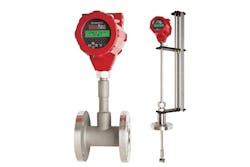Multivariable & Dual-Sensor Technologies Offered in Vortex Flow Meters
Vortex flow meters are measuring an increasing number of variables. While traditional single-variable vortex meters measure volumetric flow, newer multivariable meters include pressure and/or temperature sensors to measure mass flow. Sierra Instruments introduced the first multivariable vortex flow meter in 1997 with a resistance temperature detector (RTD) and a pressure transducer with a vortex shedding flow meter. By using the information from these sensors, the meter can determine volumetric flow, temperature, pressure, fluid density and mass flow. This meter is one of a growing number of multivariable new-technology flow meters, including magnetic, differential pressure (DP) and ultrasonic meters.
While multivariable flow meters are more expensive, they enable users to obtain significantly more information about the process than a less expensive single-variable meter. This information can increase efficiencies and more than make up for the additional cost. The more complex varieties can also measure mass flow, which is especially useful for steam and gas flow measurement.
In addition to process fluid flow, multivariable vortex meters have one of the following sensor configurations:
- Integrated temperature sensor; no pressure sensor
- Integrated temperature and pressure sensors
- Integrated pressure sensor; no temperature sensor
- About two-thirds of vortex multivariable vortex flow meters are shipped with an integrated temperature sensor but with no pressure sensor.
In November 2015, Sierra Instruments introduced what it calls the "next generation" of vortex meters. These meters are specifically designed for flow energy measurement in steam, compressed air, natural gas and water applications. As an update to its original meters released in 1997, new technology features include a microprocessor for faster software applications and a suite of digital communication protocols for networking and automation.
Dual-Sensor Vortex Flow Meters
Another recent development in vortex meters is a dual-sensor meter. When a bluff body generates vortices, a downstream sensor detects and counts their quantity. These sensors are typically ultrasonic, piezoelectric or capacitive, though piezoelectric sensors predominate. In another recent innovation, two sensors downstream detect the vortices to provide redundancy, making the meter more reliable but not necessarily enhancing performance.
Additionally, two vortex flow meters have been positioned in the same process line and calibrated together, providing redundancy. It is somewhat like having two ultrasonic meters running in the same line for custody-transfer applications. This arrangement does not improve individual meter performance, but it does make for a more stable and reliable installation.
Vortex meters with dual sensors downstream and dual vortex meters calibrated together today each account for a small percent of the vortex meters shipped. However, the market for both configuration types can be expected to grow at an above-average rate over the next several years. As more end-users become familiar with the redundancy that both designs offer, their popularity can be expected to increase.
Vortex meters measure steam, gases and liquids with equal ease, tolerating high temperatures in measuring saturated and superheated steam. In steam flow, their main competitor is DP meters.
For more information about Flow Research’s work in the area of vortex meters, visit www.flowvortex.com.
Jesse Yoder
Jesse Yoder, Ph.D., is president of Flow Research Inc. He has 30 years of experience as an analyst and writer in instrumentation. Yoder holds two U.S. patents on a dual-tube meter design and is the author of "The Tao of Measurement," published by ISA. He may be reached at [email protected]. Find more information on the latest study from Flow Research, "The World Market for Gas Flow Measurement, 4th Edition," at www.gasflows.com.


